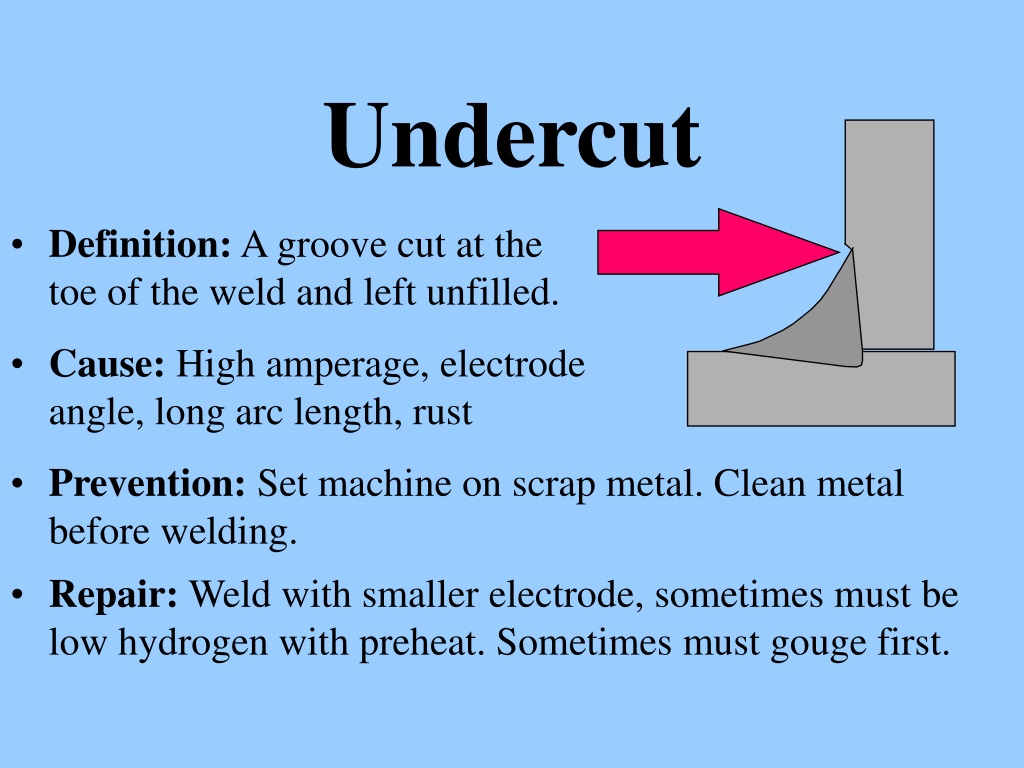Expert Techniques for Preventing Weld Undercut Effectively
Expert Techniques for Preventing Weld Undercut Effectively
Blog Article
Grasping the Art of Welding: Just How to Prevent Undercut Welding Issues for Flawless Fabrication Results
By recognizing the origin causes of undercut welding and implementing reliable methods to prevent it, welders can elevate their craft to brand-new levels of quality. In the pursuit of remarkable construction outcomes, grasping the art of welding to stay clear of undercut concerns is not just a skill but a necessity for those making every effort for excellence in their work.
Comprehending Undercut Welding

To avoid undercut welding, welders should ensure appropriate welding parameters, such as changing the existing, voltage, traveling speed, and preserving the proper electrode angle. Furthermore, utilizing the ideal welding technique for the certain joint configuration is vital. Using weaving activities or backstepping strategies can help make sure proper weld metal deposition and minimize the probability of undercut formation. Regular examination of welds during and after the welding procedure is additionally important to capture any kind of undercut very early and make necessary modifications to avoid further problems. Preventing weld undercut. By comprehending the reasons for undercut welding and carrying out preventative actions, welders can achieve premium, structurally audio welds.
Reasons of Undercut in Welding
Understanding the aspects that contribute to undercut in welding is vital for welders to create premium, structurally sound welds. Undercutting occurs when the weld steel does not properly load the groove developed in between the base metal and the previously deposited weld steel. Several variables can cause undercut in welding. One usual reason is extreme heat input. Welding at high temperature levels for prolonged durations can cause the base metal melting even more than preferred, bring about undercut. Inadequate welding incorrect or existing welding rate can also add to damage. Insufficient current might not supply enough heat to thaw the base and filler metals effectively, while excessive rate can prevent appropriate fusion, creating undercut. Additionally, inappropriate electrode angles or inaccurate lantern manipulation methods can create locations of low weld metal deposition, advertising undercut. Recognizing these causes and implementing appropriate welding techniques can assist prevent damaging issues, making certain strong and sturdy welds.
Techniques to Avoid Undercutting

To mitigate the risk of damaging in welding, welders can utilize critical welding Read More Here techniques aimed at improving the high quality and honesty of the weld joints. One reliable approach is to adjust the welding parameters, such as voltage, current, and travel speed, to guarantee proper heat input and deposition. Maintaining an appropriate electrode angle and making sure regular traveling rate can additionally aid protect against undercut. In addition, making use of the correct welding technique for the specific joint configuration, such as weave or stringer grains, can add to reducing damaging. Preventing weld undercut.
In addition, correct joint preparation, including making certain tidy base materials devoid of contaminants and using the ideal welding consumables, is critical in stopping undercut problems. Employing back-step welding strategies and managing the weld bead account can likewise help disperse warm evenly and decrease the danger of undercut. Regular examination of the weld joint throughout and after welding, in addition to implementing top quality assurance measures, can assist in dealing with and spotting damaging concerns immediately. By implementing these strategies diligently, welders can attain remarkable construction results with very little undercut flaws.
Importance of Appropriate Welding Criteria
Picking and maintaining proper welding criteria is vital for attaining successful welds with very little issues. Welding parameters refer to variables such as voltage, present, take a trip rate, electrode angle, and securing gas flow rate that directly affect the welding process. These specifications have to be very carefully readjusted based on the sort of material being welded, its thickness, and the welding method utilized.
Appropriate welding specifications make sure the ideal quantity of warmth is used to thaw the base steels and filler product consistently. If the criteria are established too expensive, it can bring about too much warmth input, creating burn-through, distortion, or spatter. On the other hand, if the specifications are as well low, incomplete fusion, absence of infiltration, or damaging might happen.
Quality Control in Welding Operations

Verdict
To conclude, grasping the art of welding requires an extensive understanding of undercut welding, its causes, and strategies to avoid it. By guaranteeing proper welding criteria and executing quality control methods, remarkable construction results can be attained. It is vital for welders to consistently pursue excellence in their welding procedures to anchor prevent undercut issues and create top quality welds.
Undercut welding, an usual problem in welding procedures, happens when the weld steel doesn't effectively fill the groove and leaves a groove or clinical depression along the welded joint.To protect against undercut welding, welders ought to make certain proper welding criteria, such as adjusting the present, voltage, traveling speed, and keeping the right electrode angle. Inadequate welding present or wrong welding speed can likewise add to damage.To reduce the threat of undercutting in welding, welders can utilize critical welding techniques aimed at improving the quality and stability of the weld joints.In verdict, understanding the art of welding requires a complete understanding of undercut welding, its causes, and techniques to prevent it.
Report this page